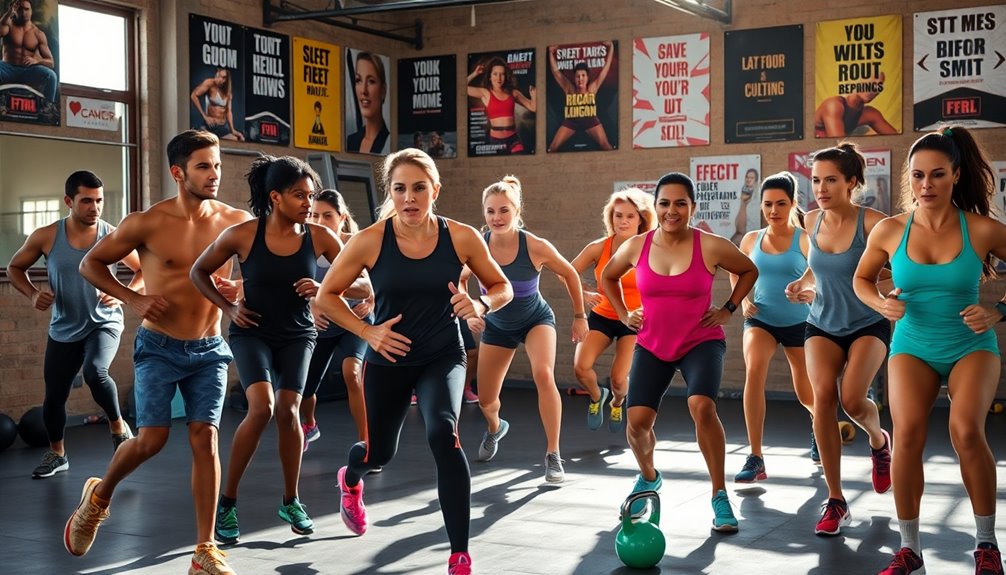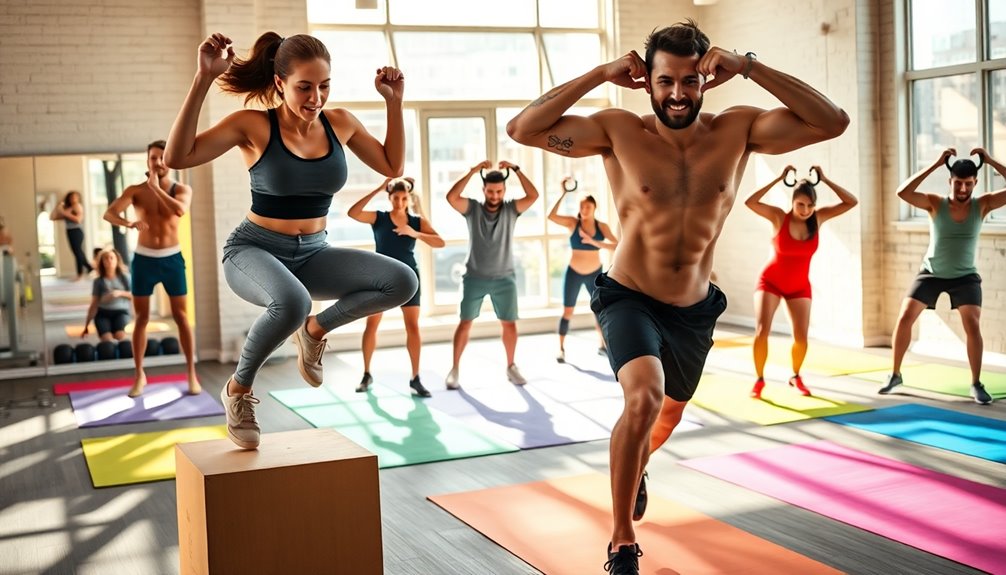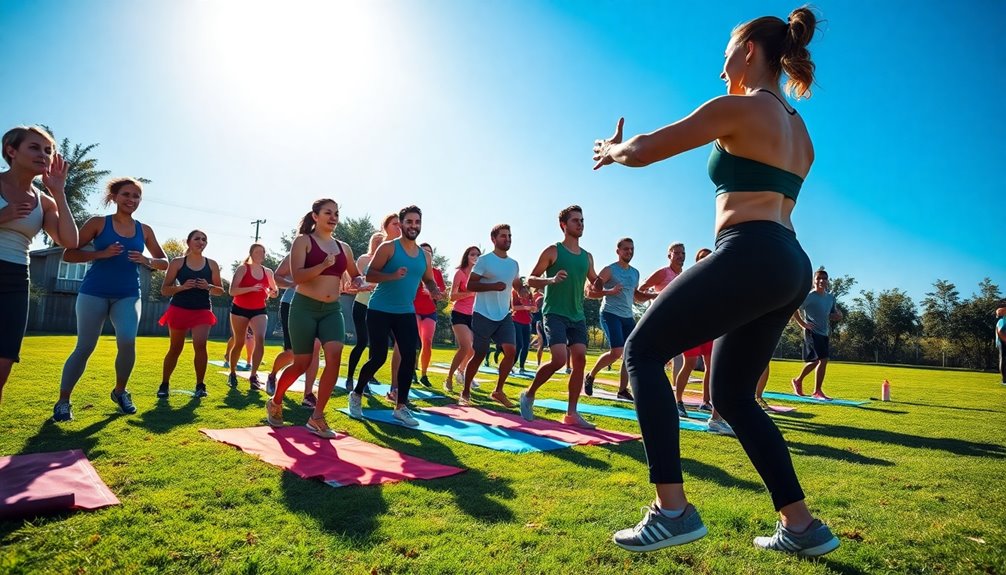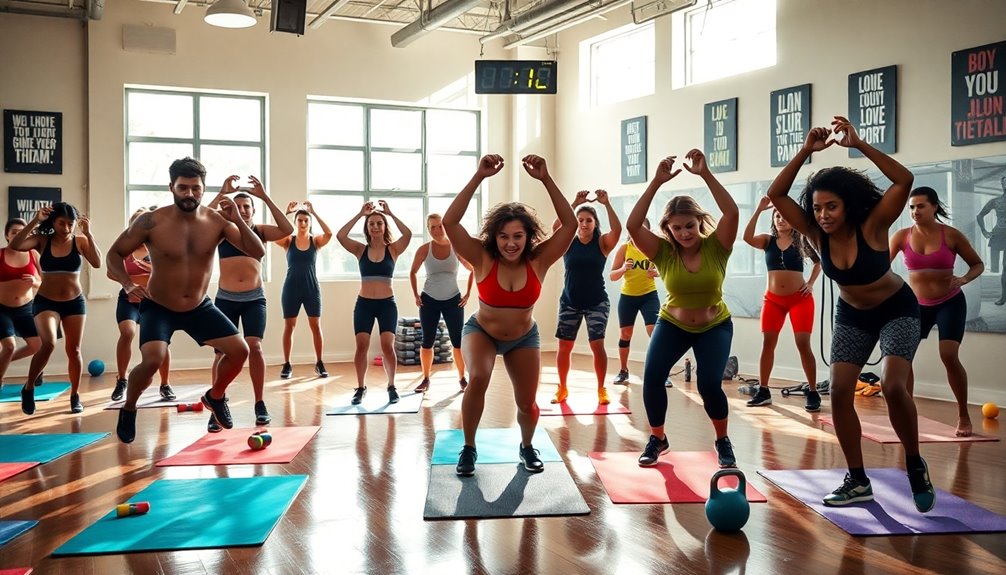HIIT workouts, or High-Intensity Interval Training, mix short bursts of intense exercise with rest periods to maximize results in minimal time. You can boost your metabolism, lose fat, and build muscle effectively, all in just 20-30 minutes a few times a week. This adaptable training style suits all fitness levels and helps improve endurance and cardiovascular health. Plus, you'll experience the afterburn effect, burning calories long after your session is over. If you're curious about the best exercises and tips to get started, there's plenty more to uncover about how to make HIIT work for you.
Key Takeaways
- HIIT workouts involve alternating high-intensity exercises with rest periods to maximize calorie burn and fat loss.
- These sessions typically last 20-30 minutes and can be highly effective for busy schedules.
- HIIT improves cardiovascular fitness, endurance, and boosts metabolism, leading to significant fat loss.
- Exercises like burpees, jump squats, and kettlebell swings engage multiple muscle groups for a full-body workout.
- Suitable for all fitness levels, HIIT can be easily adapted to individual capabilities and preferences.
Definition of HIIT Workouts

When it comes to fitness, HIIT workouts, or High-Intensity Interval Training, have gained immense popularity for good reason. You're likely looking for an effective way to maximize your workout time and achieve results, and that's where HIIT shines. This training method alternates between short bursts of intense activity and brief periods of rest or lower-intensity exercise. This structure not only keeps your heart rate up but also boosts your metabolism, leading to improved fat loss and muscle gain.
The effectiveness of HIIT lies in its unique approach. You don't need hours at the gym to see significant changes. Just a few sessions per week can yield impressive results. The beauty of HIIT workouts is their adaptability; whether you prefer running, cycling, or bodyweight exercises, you can tailor the intensity to suit your fitness level.
What sets HIIT apart is its intensity. You'll push yourself during those high-energy intervals, feeling exhilarated and accomplished. That feeling of belonging to a community of people striving for better health is powerful, and HIIT fosters that spirit. Additionally, incorporating mini band workouts into your routine can enhance muscle toning and sculpting results, complementing the benefits of HIIT.
As you share the sweat and triumphs with fellow fitness enthusiasts, you'll find motivation in each other's progress.
How HIIT Works

What Are HIIT Workouts and Their Benefits?
How HIIT Works
Understanding how HIIT operates is essential to accessing its potential advantages. At its core, HIIT, or High-Intensity Interval Training, utilizes varying intensity levels to optimize your workout efficiency. You alternate between brief bursts of vigorous activity and periods of lower-intensity exercise or rest. This approach keeps your heart rate elevated, ensuring you're not just burning calories during the workout itself but also continuing to burn fat long after you've completed.
When you challenge your body to its limits during those vigorous intervals, you're engaging fast-twitch muscle fibers and promoting a higher metabolic rate. This signifies you'll burn more fat, even at rest! Plus, the appeal of HIIT is that it can fit into any schedule. Even a 20-minute session can deliver significant results, making it ideal for busy lives.
Many find that the camaraderie of joining a HIIT class or group enhances the experience. You'll feel a sense of belonging as you sweat alongside others who share your objectives. The shared challenge creates a supportive environment that can motivate you to push harder.
Incorporating HIIT into your routine can lead to impressive gains in cardiovascular fitness and endurance. You'll feel empowered as you notice enhancements in your performance and overall health. Additionally, engaging in HIIT can also help strengthen your glutes, which is crucial for overall body performance and injury prevention.
Key Components of HIIT

At the heart of HIIT lies a few essential components that make it a powerful fitness tool. First and foremost, you'll notice the emphasis on intensity levels. During your workout, you'll push yourself to the max during short bursts of exercise, elevating your heart rate and maximizing calorie burn. This heightened level of effort is what sets HIIT apart from traditional workouts. You're not just going through the motions; you're challenging your body and mind, which can be incredibly rewarding.
Another vital element is the recovery periods. After those intense bursts, your body needs time to recover. These short breaks are just as significant as the workout itself. They allow you to catch your breath and prepare for the next high-intensity interval.
This balance of effort and rest is key to reaping the full benefits of HIIT. It's about finding your rhythm and understanding how your body responds to both intensity and rest. Additionally, incorporating techniques from core training approaches can enhance your overall performance and stability during HIIT workouts.
Popular HIIT Exercises

Building on the intensity and recovery periods that define HIIT, let's explore some popular exercises that can elevate your workout routine. These exercises aren't only fun but can also be tailored to fit your fitness level, making it easy for you to join in and feel a sense of belonging with others in the fitness community.
One of the best exercises to start with is the burpee. It combines a squat, push-up, and jump, offering a full-body workout that's incredibly effective.
If you're looking for something that requires little equipment, jump squats are another great option. You can do them anywhere, and they work wonders for your legs and core.
For those who prefer using the best equipment, kettlebell swings and battle ropes are excellent choices. Kettlebell swings engage multiple muscle groups and help improve your strength and endurance, while battle ropes deliver an intense cardio session that'll leave you breathless.
You might also enjoy high knees and mountain climbers; both can be easily integrated into effective routines. These exercises keep your heart rate up and can be performed in quick bursts, making them perfect for HIIT.
Don't forget about incorporating core exercises like planks and Russian twists. These not only build strength but enhance your overall stability.
Whether you're at home or in a gym, these popular HIIT exercises will help you connect with your fitness goals and foster a sense of community among fellow enthusiasts. So why not give them a try? You won't regret it!
Benefits of HIIT Workouts

HIIT workouts offer a multitude of benefits that can transform your fitness journey. Whether you're short on time or looking to maximize your results, HIIT effectiveness shines through in various ways. By incorporating high-intensity intervals, you can achieve remarkable improvements in your overall health and fitness. Here are some standout benefits that make HIIT workouts a must-try:
- Time Efficiency: You can complete an effective workout in as little as 20-30 minutes.
- Improved Endurance: HIIT boosts your cardiovascular fitness, helping you tackle everyday activities with ease.
- Fat Loss: Experience significant fat loss while preserving muscle mass, thanks to the afterburn effect.
- Versatility: HIIT can be tailored to any fitness level, which means everyone can join in and feel included.
- Increased Metabolism: Your metabolism stays elevated long after your workout, leading to better HIIT results.
These benefits highlight why so many people are turning to HIIT as a go-to fitness solution. You'll find that the more you engage with HIIT, the more empowered you feel in your abilities. Additionally, incorporating effective exercise routines can further enhance your overall fitness experience and results.
With such notable HIIT effectiveness, it's no wonder that this training style has gained a loyal following. By embracing HIIT workouts, you're not just committing to a fitness routine; you're joining a community that prioritizes health and progress.
HIIT vs. Steady-State Cardio

When comparing HIIT to steady-state cardio, understanding the distinctive advantages each workout style offers is pivotal. Both have their merits, but you might find that HIIT effectiveness aligns better with your fitness goals.
HIIT workouts involve short bursts of intense exercise followed by brief recovery periods. This approach not only maximizes calorie burn in a shorter time but also boosts your metabolism, making it a time-efficient choice for busy individuals.
In contrast, steady-state cardio, such as jogging or cycling at a consistent pace, promotes endurance and can be gentler on the joints. It's often seen as a more manageable option for those new to exercise or recovering from injury.
However, if you're looking for a more dynamic and engaging workout, the variety that HIIT brings can keep you motivated and excited about your fitness journey.
When you consider a HIIT comparison to steady-state cardio, think about what you're aiming to achieve. If you're focused on fat loss, muscle gain, and improving cardiovascular fitness rapidly, HIIT might be your best bet. On the other hand, if you enjoy long, steady workouts and find them relaxing, steady-state cardio could be more your style. Additionally, incorporating the Half Day Keto program into your fitness routine can enhance your results by supporting your body's natural metabolic processes.
Ultimately, the best workout is the one you'll stick with. Try incorporating both styles into your routine to experience the unique benefits each offers and discover what truly resonates with you. After all, fitness is about finding what feels right and building a community around that journey.
Ideal HIIT Workout Duration

Finding the right duration for your HIIT workouts can make a significant difference in your results and overall experience. When it comes to ideal timing, most experts suggest that HIIT sessions should last between 15 to 30 minutes. This timeframe allows you to push your limits while still being manageable, keeping you motivated and engaged.
To help you determine the best duration for your workouts, consider these key factors:
- Fitness Level: Tailor your workout duration based on your current fitness level. Beginners might start with shorter intervals.
- Effective Intervals: Focus on maximizing your effort during those high-intensity bursts, typically ranging from 20 to 40 seconds, followed by adequate recovery.
- Workout Goals: Whether you want to lose weight, build endurance, or improve speed can influence how long you should work out.
- Weekly Frequency: The number of times you plan to do HIIT weekly affects how you structure each session.
- Recovery Time: Make sure you allow enough time for recovery to prevent burnout and injury.
Incorporating a meal replacement like smoothies can also support your recovery and overall weight loss journey.
Tips for Beginners

Starting a new workout regimen can be both exciting and intimidating, especially with high-intensity interval training (HIIT). If you're new to HIIT, it's crucial to approach it with a plan that makes you feel confident and connected to others on this fitness journey.
First, focus on mastering proper form. This isn't just about looking good; it's vital for preventing injuries and maximizing your workout's effectiveness. Take the time to learn the correct techniques for each exercise. You can watch instructional videos, attend a class, or even enlist a friend who's experienced in HIIT to help guide you. Remember, everyone starts somewhere, and asking for help fosters a sense of community.
Next, commit to progress tracking. Keep a journal or use an app to log your workouts, noting the exercises, durations, and how you felt afterward. This not only keeps you motivated but also helps you see how far you've come over time. Celebrate those small victories! Whether it's increasing your reps or simply feeling stronger, recognizing your progress can make a world of difference.
Lastly, don't rush the process. HIIT is intense, and it's okay to start with shorter intervals and gradually build up your endurance. Engaging with fellow beginners can provide support and encouragement, creating a sense of belonging that makes your HIIT journey all the more enjoyable. Remember, many people use custom keto diet plans to enhance their overall fitness and health, which can complement your HIIT workouts. You've got this!
Common Mistakes to Avoid

In the rush to immerse themselves in HIIT workouts, many beginners overlook some common pitfalls that can hinder their progress and enjoyment. Avoiding these mistakes can make all the difference in your experience and results. Here's what to watch out for:
- Neglecting proper form: It's tempting to push yourself through each exercise, but sacrificing proper form can lead to injuries. Focus on mastering the movements first.
- Skipping rest intervals: HIIT is all about intensity, but don't underestimate the significance of rest. Allowing your body to recover is vital for maximizing your performance and preventing burnout.
- Going too hard, too fast: Starting with an intensity that's too high can be overwhelming. Gradually increase your effort as your fitness level improves.
- Ignoring warm-ups and cool-downs: Preparing your body before and after your workout helps prevent injuries and aids recovery. Make sure to include dynamic stretches before and static stretches afterward.
- Not tracking progress: Keeping a record of your workouts, including the exercises, durations, and how you felt, can help you stay motivated and focused on your goals.
- Overuse of forearm muscles: Failing to balance HIIT with proper strength training can lead to overuse injuries in the forearms and elbows, underscoring the importance of conditioning.
Incorporating HIIT Into Your Routine

After avoiding common mistakes, you might wonder how to effectively infuse HIIT workouts into your fitness routine. The beauty of HIIT is its adaptability, making it a fantastic match for anyone, regardless of your schedule or fitness level. Start by identifying your timing challenges. Are you pressed for time during the week? Try scheduling short, intense sessions of 15-30 minutes, which can fit neatly into your lunch break or early morning.
Next, consider your equipment options. You don't need a fully equipped gym to reap the benefits of HIIT. Bodyweight exercises like burpees, jump squats, or mountain climbers can be incredibly effective. If you have access to dumbbells, kettlebells, or resistance bands, you can add variety and intensity to your workouts.
To get started, choose a workout structure that resonates with you. You might opt for a 20-second high-intensity exercise followed by a 10-second rest, repeating for several rounds. Alternatively, a minute of intense effort followed by 30 seconds of rest can also work wonders.
Lastly, remember to mix it up! Incorporate different movements and lengths of workouts to keep things fresh and engaging. Whether you connect with a workout buddy or join a class, you'll foster a sense of belonging in your fitness journey. So, immerse yourself, embrace the challenge, and enjoy the incredible results that come with incorporating HIIT into your routine!
Frequently Asked Questions
Can HIIT Workouts Be Adapted for Older Adults?
Absolutely, HIIT workouts can be adapted for older adults! You can incorporate adaptive modifications to guarantee safety and comfort. Start with low-impact exercises and gradually increase intensity for safe progression. It's all about listening to your body and finding what works for you.
Joining a supportive community can make this journey enjoyable and motivating. You'll discover that with the right approach, HIIT can enhance your fitness and overall well-being at any age!
How Often Should I Do HIIT Workouts Weekly?
Think of your body as a well-tuned engine; it needs the right fuel and maintenance to run smoothly. You should aim for HIIT workouts about 2 to 3 times a week for proper frequency. This keeps your body challenged without overwhelming it, minimizing potential risks of injury.
Listen to your body and adjust as needed. Remember, finding the right balance helps you feel connected and strong within your fitness community.
Are There HIIT Workouts Suitable for Beginners?
Absolutely, there are HIIT workouts perfect for beginners! You can start with modified routines that focus on lower intensity and shorter intervals. These gentle progressions help you build stamina and confidence without overwhelming yourself.
Look for beginner-friendly classes or online videos that emphasize proper form and technique. Remember, everyone starts somewhere, so embrace your journey and enjoy the sense of community that comes from working out with others at your level!
What Equipment Do I Need for HIIT Workouts?
When it comes to HIIT workouts, you've gotta have the right tools for the job!
If you're working out at home, bodyweight exercises can do wonders, but if you hit the gym, you might want some equipment like kettlebells or resistance bands.
Both options can deliver a killer workout, so choose what fits your style.
No matter where you are, the key is to keep it fun and engaging with the right gear!
Can I Combine HIIT With Strength Training?
Absolutely, you can combine HIIT with strength training! By incorporating HIIT modifications, you can tailor your workouts to suit your fitness level. This mix not only boosts your endurance but also builds muscle.
Consider using HIIT progressions, such as increasing intensity or adding weights, to keep challenging yourself. It's a great way to stay engaged and feel accomplished, fostering a sense of belonging in your fitness journey.
Conclusion
So, if you thought you'd escape intense workouts by choosing HIIT, think again! But here's the twist: those short bursts of effort can actually save you time while delivering impressive results. Embrace the challenge, and you'll not only burn calories but also boost your endurance and strength in less time than a traditional workout. So, lace up those sneakers and get ready to sweat—because who knew getting fit could be so efficient?



